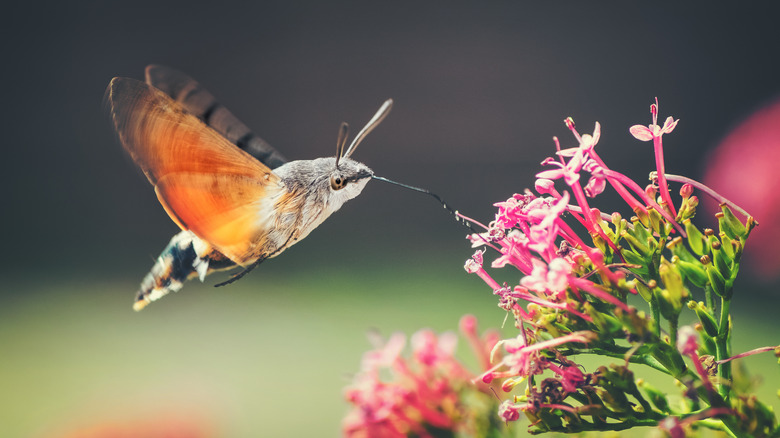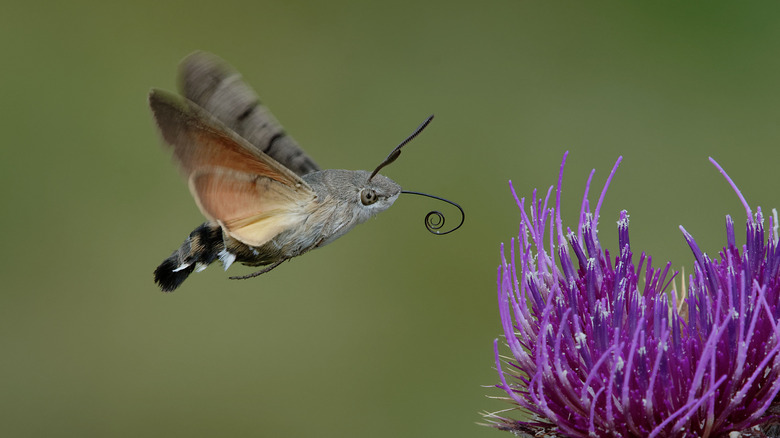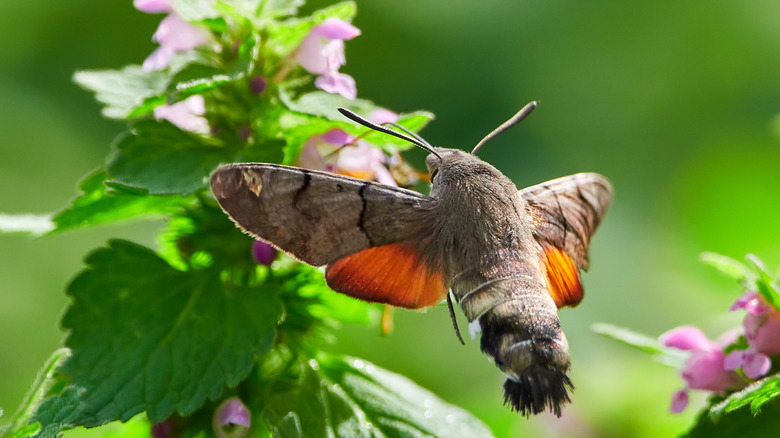The Exquisite Moth You Might Be Mistaking For A Hummingbird In Your Garden
Hummingbirds flocking to your garden can put on quite a show around flowering plants and backyard feeders. When it comes to pollen-spreading insects, though, there's a type similar in size, appearance, and behavior that can indeed be mistaken for one of these lively little birds. What is it? The hummingbird moth, of course.
In regard to coloring, hummingbird moths — sometimes called sphinx moths or hawk moths — tend to be brown with some reddish accents on their wings. At first glance, these hues are similar to those found on Rufous and Allen's hummingbirds. Hummingbird moths flit around in a manner akin to hummingbirds, and they can hover in front of flowers in a similar way, too. Even the buzzing noise they make sounds a little like the hummingbird's.
There are a couple of main differences in the appearance of hummingbird moths and hummingbirds, though. For one, hummingbird moths have hairy antennae on their heads that hummingbirds lack. Another is that hummingbirds have a long beak concealing their lengthy nectar-lapping tongues while hummingbird moths unfurl theirs from beneath their chins. When a hummingbird moth's tongue is extended to take a sip of nectar, that makes it look even more like a hummingbird. In certain areas, you could very well spy both of these interesting fliers in your garden.
Where hummingbird moths thrive
If you're now intrigued about hummingbird moths and want to get a glimpse of one, they can be found around the world. A few different types live in North America, and all are part of the Hemaris genus. Two of the most common are the Snowberry Clearwing and the Hummingbird Clearwing. Snowberry Clearwings are more prevalent, while Hummingbird Clearwings congregate more in the eastern half of the country. Regardless of the actual type, most people just refer to them as hummingbird moths.
Attracting more of these interesting insects to your yard is easy in many areas since they'll sip nectar from a variety of flowers beginning in the spring. Beebalm, phlox, and verbena are particularly appealing to them in the summertime and several flowering plants and trees are essential to their developing larvae. These include dogbane, plums, cherries, and hawthorn. Honeysuckle is attractive to both feeding adults and their larvae, so if you live in an area where this vine readily grows, you may find planting it will draw them onto your property. Do note, though, that they tend to frequent plants with white blooms at night and more colorful blooms during the day.
The pros and cons of hummingbird moths
If you believe in signs of fate, seeing a hummingbird moth might predict good fortune. This legend came about when a throng of bee hawk-moths (the name for these intriguing insects in England) was seen winging their way across the English Channel on D-Day during World War II and taken as a sign of good luck. Even if you don't think an insect can foretell a favorable outcome, there are some other good reasons to want them around.
While hummingbirds find a safe spot to sleep at night, hummingbird moths continue to buzz around gardens into the wee hours. That means they're working their pollinating magic even after dark. Since gardens need flying insects to survive and produce flowers, fruits, and veggies, gardeners usually don't mind attracting pollinators like these to a yard all day long.
However, an overabundance of hummingbird moths can lead to large numbers of sphinx caterpillars that may damage vegetation in yards and gardens. Since hummingbird moths don't sting or cause harm to humans, that's the only real drawback to having them around (even their larvae go unnoticed!). Most of the time, it's more important to protect various pollinators than eliminate them. You'll enjoy seeing these beneficial insects flitting around your flowers on occasion, in addition to the hummingbirds they're often mistaken for.


